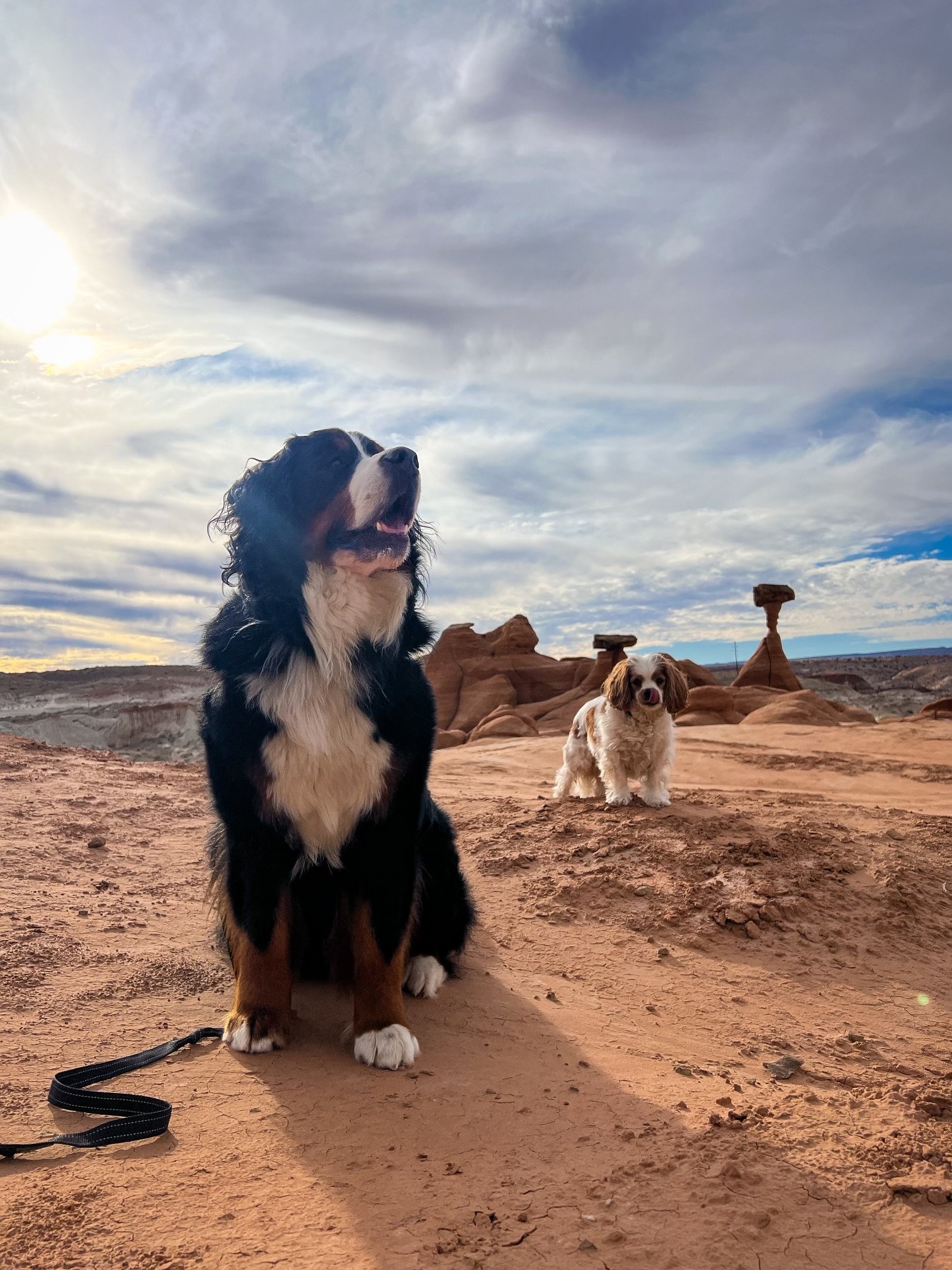First Aid for Dogs
Traveling and exploring with your pets can be a great adventure with many memories. It can also come with its risks. While we are not experts when it comes to pet first aid, we’ve been doing lots of research on how to make sure our boys are taken care of in case of an emergency.
Kevin and Benny exploring hoodoos during a hiking in Utah
When exploring new places with your dog, you might find yourself on a trail. Hiking with dogs is fun for everyone, but can also increase the risk of injury, so make sure you’re prepared. We’ve compiled some steps to preparing for any adventure with your dog.
1. Know the signs
It’s hard to know when your dog is in pain. They are resilient animals. Some might not show physical signs until the pain is really bad or maybe show no signs at all. Knowing your dog's behavior and being able to see signs of discomfort or distress is key to keeping your pet happy and healthy. A great way to understand how your dog is feeling, is to research how to read your dogs body language to make sure we know what they are communicating with us.
Unless they’ve been in pain or had injuries before, you may not know how your pet will react. Pain and stress could cause aggression, so proceed with caution.
2. Be prepared with the right gear
Heatstroke in dogs happens more than you think, especially when you are exercising your dog. Make sure to carry dog gear to help your dog stay cool if they become overheated.
Symptoms of heatstroke include stopping and not moving, excessive drooling, heavy panting and rapid breathing. An early sign of heatstroke is cherry red gums and a bright red tongue.
If you live in a place with a lot of sunshine, and are hiking on a paved trail, it might be good to invest in dog booties! When it’s over 89 degrees outside, the asphalt trail or sidewalk can reach unsafe temperatures for your dog’s paws.
Hiking Essentials
Water for your dog and a packable water bowl
Cooling vest for days with a lot of sun
Enough water for yourself
Emergency dog lift harness in case your dog cannot walk
Dog booties, depending on the temperature
First Aid Kit
3. Educate yourself in pet first aid & CPR
Believe it or not, there are classes pet parents can take to learn first aid and CPR for pets.
Honestly, I didn’t even know there was such a thing until I started researching pet first aid.
You can learn so much from the comfort of your own home. Youtube , Academy for Canine Educators and the Red Cross are all great resources from basic know-how to certified First Aid for Pets lessons.
There are many forms of pet emergencies and we know it can be hard to be prepared for every single one. But there is one more common than others. Choking.
Would you know what to do if your dog started choking? There are actually different Heimlich maneuvers for small, medium and large dogs. I researched choking after a few close calls. I recently found the Bow Wow Buddy which is a device that holds bully sticks so they are unable to swallow the last bit of the stick during an enthusiastic chew session.
4. Put together a DIY Dog First Aid Kit
There are some really great first aid kits for pets you can purchase online, or if you have most of the items at home, and want to save some money, you can just put one together yourself.
While doing research, we wanted to share some items we found to be important to have on hand in case of a pet emergency.
Phone number, clinic name, address of your veterinarian as well as local veterinary emergency clinics
Absorbent gauze pads
Adhesive tape
Cotton balls or swabs
Ice pack
Disposable gloves
Scissors with blunt end
Tweezers
OTC antibiotic ointment
Oral syringe or turkey baster
Towels
Small flashlight
Alcohol wipes
Styptic powder
Saline eye solution
Artificial tear gel
Musher’s secret, or equivalent for cracked paws
5. Get Pet Insurance
Vet visits aren’t cheap, especially if it's an emergency. And if it’s an emergency, we didn’t want to worry if we could afford the care they need.
That’s why we decided to get pet insurance with Healthy Paws. When Kevin came along, he gave us a bit of a scare. We thought he had bloat - which can be life threatening and common in Bernese Mountain Dogs - and his emergency vet visit cost us hundreds of dollars. But thanks to pet insurance, we were able to snap a picture of the bill and submit it right away through the Healthy Paws app. Within a couple weeks, we received a reimbursement check in the mail!
We hope you’re able to take these first steps before your next adventure. Preparation is key when you’re exploring with your dog. Make sure your adventures are worry-free by having the right tools in place. Pack your first aid kit, bring enough water and gear, learn enough to know when your dog is in pain, and remember the ways to help them in case of an emergency. Happy trails!




